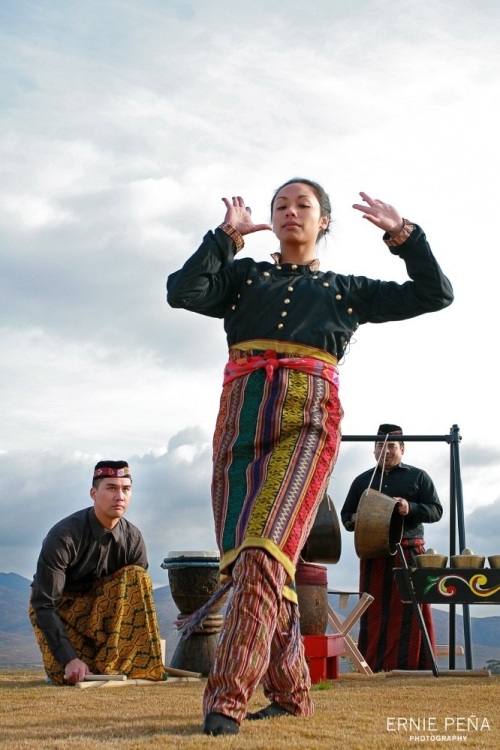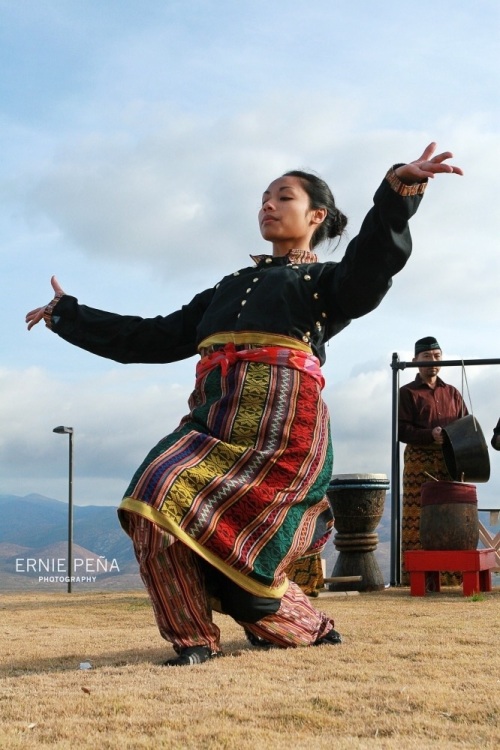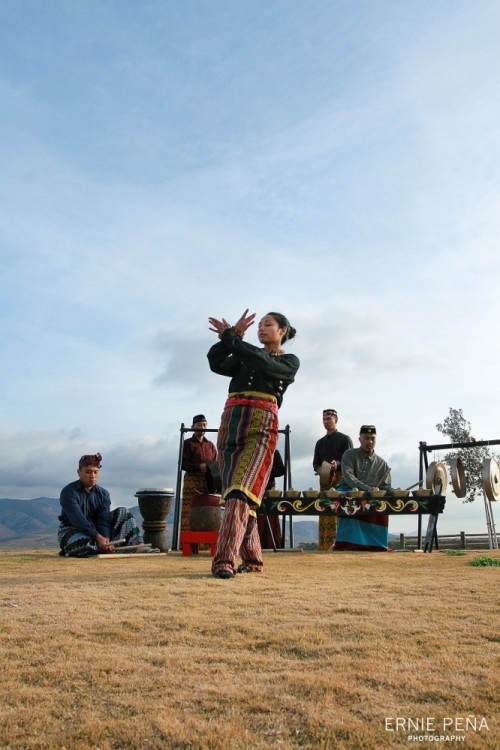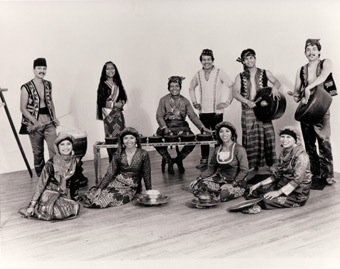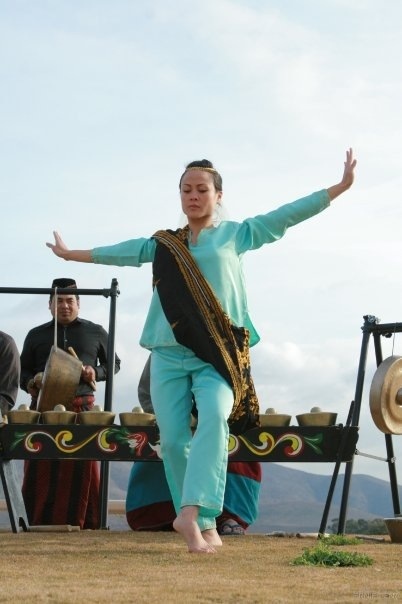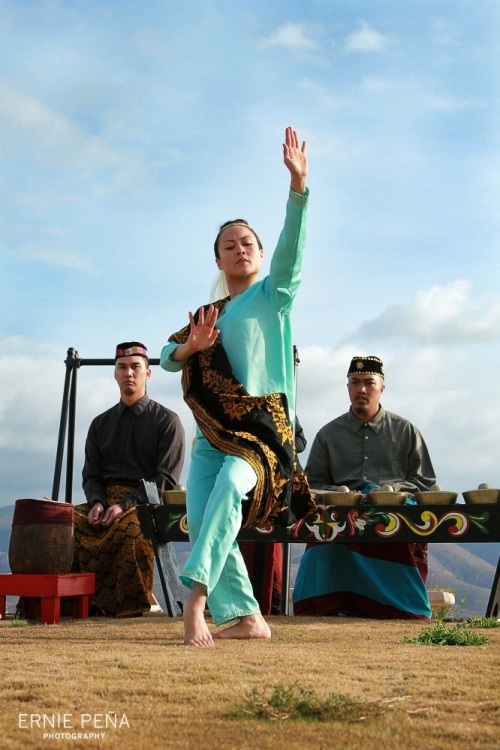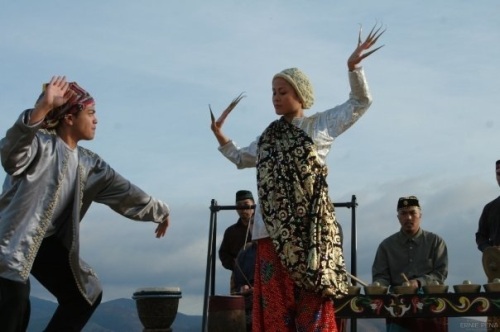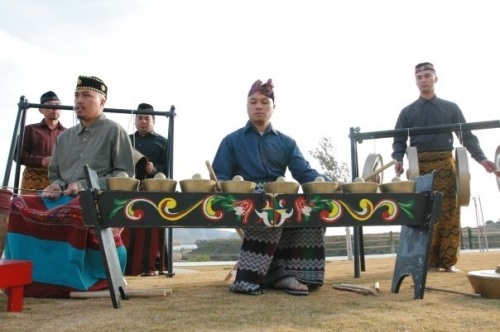Kulingtangan, the Music of Resistance
Kulintangan is a product of the indigenous communities of the Philippines and has proudly been considered “the music of resistance” against the harsh realities of Spanish colonization. Folk life traditions such as kulintangan are critical to affirming identity and community. They do so by connecting immigrants to their heritage, facilitating communication between generations, and creating a sense of community that spans the globe.
The national culture of the Philippines is strongly influenced by western civilization, and many of todays Filipinos have grown up with the view of having no other cultural past than a colonial one. For the last 500 years, the Philippines has been dominated by Spanish colonialism, American rule and Western influence. In actuality, a plethora of ethnolinguistic minorities have lived throughout the islands, maintaining customs that date back far before foreign presence. Kulintangan is little known and less frequently practiced compared to such quintessential Philippine folk arts like tinikling, itik-itik or maglalatik, which reflect more than 300 years of Spanish rule and influence.
Below are pictures from a photo shoot with Ernie Pena a few years ago. The instruments and costumes were all obtained during field work research in the Philippines, as these are not readily available in America. PKE Members pictured here include Bernard Ellorin, Raynard Abalos, Sev Reyes, Chris Feraro, Jhoselle Padilla, and Eric Abutin.
Pic 1: Paunjalay; Music: Te-ed
Pic 2: Paunjalay 2
Pic 3: Paunjalay; Music: Te-ed
Photo credit Ernie Pena
KulArts Philippine Tribal Tour 2013
PHILIPPINE TRIBAL TOUR 2013
Tribes of Mindanao, Philippines
February 1-12, 2013
Excerpt taken from http://kularts.org/wp/programs/tribal-tour/. KulArts Tribal Tour
Since 2002, Kularts has conducted its one-of-a-kind Tribal Tour, a hands-on field study, custom-designed for participants to explore, discover, and draw empowerment from indigenous Pilipino cultures of Mindanao. During the 12-day trip, participants will engage in meaningful interactions with T’boli, B’laan, Maguindanaon, and Manobo tribal leaders, shamans & healers, and masters artists in their ancestral homes in Davao del Sur, Sanggani, South Cotabato, and Maguindanao.
Please note that there is an application and interview process for each prospective tour member. Eligibility for participation in this tour requires contacting Kularts for an application and meeting the Participant Qualifications.
The application deadline w/ $50 non-refundable fee is November 15, 2012 (no refunds unless tour is cancelled.)
Kulintang Arts, Inc. popularly known as Kularts, was founded in 1985 by Robert L. Henry, Marcella Pabros, and Alleluia Panis to support the work of Kulintang Arts Ensemble (KAE), a ten-member music and dance company whose contemporary work was rooted in the indigenous traditions of the Pilipino people.
PKE on YouTube
On the islands of Mindanao and the Sulu archipelago, the kulintang and kulintangan (kulintang-on) gong chime tradition from the Islamized Filipinos are highly favored for celebratory occasions, weddings, social gatherings, and for driving away evil spirits. Like the gangsa, it is an indigenous form of Philippine music that should not be mistaken as “MUSLIM” music. Larger knobbed gongs and drum instruments are the main accompanying instruments to the compositions found in the Maguindanaon palabuniyan (Pah-lah-boo-knee-on), the Maranao Kakolintang (Kah-koh-lintang), and the Sama Tagunggu (tah-goong-goo) ensembles. Dances among the Maranao, Maguindanao and Sama are for rituals, for re-enacting epic stories and mimicking nature.
The Maranaw: are the people of the lake who have refined the kakolintang (Kah-kolintang) tradition in their province of Lanao Del Sur. Professional musicians and dancers are highly favored to perform for any special occasion whether it be for the completion of Ramadan, weddings, or for social gatherings. The Kalilang (Kah-lee-long) or feast with kolintang music is a ritual practice that is the essence of expressing the cultural arts of the Maranaw.
The Maguindanao: As the people of the flooded plain, the Maguindanaon Palanbuniyan gong ensemble tradition of Cotabato province is divided into two styles: the Kamamatuan (kah-ma-ma-two-on) or old style and the Kangungudan (kahn-gung-goo-dawn) or new style of pieces. Instruments in the Maguindanaon kulintang ensemble include the kulintang, the main melodic instrument consisting of eight knobbed gongs laid in a row, the dabakan (dah-bah-kahn) the gourd shaped drum with lizard skin, the agong (two larger knobbed gongs) and the gandingan (gone-ding-on) the four hanging knobbed wide rimmed gongs used for communication.
The first video is a PKE practice of the Kapagnor performance.
Kapagonor: derived from the Maranao root word onor or professional, Kapagonor is played to welcome an important guest to a Maranao village.
The next video is a PKE practice of the Binalig performance.
Binalig: a kangungudan or new style piece that will be played on the kutiyapi two stringed boat lute.
Pakaraguian Kulintang Ensemble, in the past, has practiced at the Kalusugan Community Services Filipino American Wellness Center, located in National City, CA. The footage was taken in 2006 and posted to YouTube in 2008.
The Tagalog word kalusugan translates to health in English. For more information on Kalusugan, please click on the following link.
Concert of Traditional Music and Dances of the Southern Philippines
On August 1, 2009, Pakaraguian Kulintang Ensemble had one of its most exciting concerts.
Below is the press release:
Concert of Traditional Music and Dances of the Southern Philippines featured at The Neurosciences Institute Auditorium in La Jolla.
The SAMAHAN Filipino American Performing Arts and Education Center proudly presents the concert entitled, Pakaraguian – Music and Dances of Southern Philippines, on August 1, 2009, Saturday, at 7:00 o’clock in the evening at The Neurosciences Institute Auditorium at 10640 John Jay Hopkins Drive, La Jolla, CA 92121. This is the first time a concert featuring Philippine music is featured and generously underwritten by The Neurosciences Institute (NSI), as part of Performing Arts at The Neurosciences Institute, a series of cultural events presented as a community service to support arts in San Diego to underscore the special relationship between the arts and the brain.
Kulintang music, considered the highest form of gong music in the country, is an ancient form of music that has been played for centuries by the indigenous peoples in the Philippines, predating the Islam, Christian and Western influences. Mindanao’s traditional music, as well as their dances, is to some extent, similar to the culture of the Southeast Asian countries like Malaysia, Indonesia and Southern Thailand.
The Samahan Philippine Dance Company and Pakaraguian Kulintang Ensemble, directed by Ethnomusicologist, Bernard B. Ellorin, will perform indigenous Mindanao kulintang, kutyapi and gabbang music, dances and rituals of five ethno-linguistic groups, such as Maranao, Manguindanao, Sama, Tausog and Yakan. The members of the dance and music ensembles aim to present the Southern Philippines’ indigenous music and dances closest to the traditional form, in the way that they have learned from noted Mindanao and Sulu Masters, such as Maguindanao Kulintang Master Danongan Kalanduyan and his brother, Kanapia; Pangalay dance practitioner and author, Bai Ligaya Fernando Amilbangsa; Magui artists – Teng Emba, Akmad Siao and Faisal Monal; and Maranao Ethnomusicologist, Dr. Usopay Cadar.
A number of the dances and rituals that will also be presented during the Pakaraguian concert are based on the research studies done by Ellorin during his visits in Mindanao, as a three-time participant, starting in 2003 of the KulArts Tribal Tours in the island. Included in the presentation are Maranao dances, Kapagapir and Kasingkil, as demonstrated at the Mindanao State University cultural workshops where the participants studied Maranao music and dance with Jallaludin Casnor and Mindaya. Presented also will be Yakan kwintang music and Paunjalay dance, learned by Ellorin from Roxas Ahadas, brother of Uwang Ahadas, the blind Yakan musician who is the recipient of Gawad sa Manlilikha ng Bayan. Presented as well, are Tausog and Sama dances, kulintang music and folk song, Baleleng, taught by the native masters, Taalao Manandao, Salmeno Elang, Timallay Gilasti and Mahail Hajan. They were the resource persons of Ellorin’s Masters in Music thesis, Variants of Kulintangan Performance as a Major Influence of Musical Identity Among the Sama in Tawitawi, Philippines.
Showcased also during the performance is the collection of colorful, hand-crafted Mindanao native attire and props that were personally acquired by Ellorin during his tours. Collaborating with Ellorin in staging the indigenous dances and rituals, are UCLA World Culture graduate, Peter Paul De Guzman and UCSD Ethnic studies graduate, Joseph Allen Ramirez. De Guzman trained in Philippine ethnic and folk dances with the Ramon Obusan Folkloric Dance Group in the Philippines, Kultura Folk Arts in LA and with Bai Ligaya Amilbangsa. Ramirez, who is also affiliated with the Katutubo Alliance of Lumads, Lipis, Igorots, Moros, Mangyans, Aetas and Palawanons, has studied also Pangalay dance with Bai Amilbangsa and also learned Apsara Cambodian classical dancing.
The Samahan Philippine Dance Company’s principal dancers, Jhoselle Padilla, Melanie Calimlim, Mary Grace Nievera and Rowell Mateo will be performing, conventionally, dances, namely, Linggisan, Igal, Pamansak, Kapagapir, Sagayan, Pangalay, Paunjalay, Silung sa Ganding, and Kasingkil. These dance names are familiar to Philippine dance audiences because these have been interpreted and choreographed theatrically by various Filipino dance groups all over the world. For so long, the choreographed performances of the Southern Philippine dances accompanied with harsh gong beatings and unintelligible kulintang pieces have been mislabeled as the “Muslim Suite” of Philippine dance repertoire. Devotees of the religion find it irreverent that the choreographed dances and gong beats are called “Muslim” dance and music. “There is no such thing as a Muslim dance and music,” stated Master Kalanduyan during a Kulintang workshop in UCLA.
Regular members of the Kulintang music ensemble who have trained with the native Masters and have been playing with Ellorin are Eric Abutin, Chris Feraro, Mitchell Almoite, Szilvia Soprioni and Raynard Abalos. Along with Abutin and Feraro, Ellorin initially learned to play traditional Kulintang music from Master Kalanduyan, starting at a young age of twelve as a musician with Samahan Performing Arts in 1994. He went on to obtain his Bachelor of Arts in Ethnomusicology, cum laude, from UCLA and Masters in Music from the University of Hawaii, Manoa. He is currently pursuing his PhD in Music majoring in Ethnomusicology at UH, Manoa. He also attended classes in Philippine music, performance ensemble classes for kulintang, gangsa and rondalla music at the College of Music in the University of the Philippines. Programs of the Samahan Filipino American Performing are partly funded by the City of San Diego Commission for Arts and Culture, corporate and individual sponsors.
PKE is now on Facebook
PKE is now of Facebook
Please feel free to join the group, which includes not only performers and members for the Pakaraguian Kulintang Ensemble but the community at large as well.
Please click on the following link for more information.
https://www.facebook.com/#!/groups/21516137811/
Michelle Camaya, PKE Dancer
Michelle Aguilar Camaya is one of Pakaraguian’s most talented dancers.
Biography: Mochi started dancing at the age of 4. Over the years, she has studied various genres including Philippine folk dance, ballet, jazz, modern, ballroom, hula, hip-hop, Lindy Hop, and theatrical.
She has appeared on stage, in movies, and on television. She was in Disney’s The Lion King on Broadway as well as the 1997 animated adventure film Enchanted. Michelle was a spring festival dancer in the 2005 movie Memoirs of a Geisha. In 2008, she was one of the contestants on Bravo TV’s reality series Step It Up and Dance.
To hear more from Mochi herself, please go the following link:
http://www.imdb.com/video/hulu/vi2502033433/
Ligaya Fernando-Amilbangsa, Renowned Dance Scholar

Photos courtesy of Earthian Magazine.
Ligaya Fernando-Amilbangsa is a renowned dance scholar from the Sulu region of the Philippines and is the author of the book Pangalay: Traditional Dances and Related Folk Artistic Expressions.
Ms. Fernando-Amilbangsa recently published an article on Inquirer News website. Please click on the following link to see the article.
She is also the Founder of the Tambuli Cultural Dance Troupe of the Sulu College of Technology and Oceanography in Tawi Tawi. Pakaraguian began collaborating with her in 2007 as part of the anthropological field research project, Preserving the Ancient Tradition of Kulintangan. She has set up a network of kulintangan ensembles, cultural institutions and other local contacts in Sulu, where she has spent nearly 30 years mastering and studying local folk traditions.
For more information on her books, please go to the following link:
goodreads.com author profile
Amazing Photos by Ernie Pena
The late Ernie Pena was an accomplished photographer who kindly arranged a photo session for PKE in August 2009.
These photos were taken in Chula Vista, California.
FilamNet published a touching article about how the loss of Ernie Pena has affected the community. Please click on the following link for more information. Article
Samahan Philippine Dance and Danongan Sibay Kalanduyan
Pakaraguian, though formed in 2003, is by and large connected to the Samahan Philippine Dance Company, also based in San Diego, California.
Danongan Sibay Kalanduyan, master artist/teacher of Kulintang Music, came to San Diego as a guest teacher from 1989 to 1991 and again from 1994 to 1997.
He introduced Samahan to the authentic music of the Maguindanao and Maranao people of the Philippines. Kalanduyan was a recipient of the prestigious National Heritage Fellowship Award in 1995. His patient guidance resulted in the development of Bernard Ellorin, a Samahan performer who would later become one of the founders of PKE.
For more information, click on the following link.
Samahan Music Ensembles
PKE’s 10 Year Anniversary
Pakaraguian Kulintang Ensemble was formed in September 2003 by UCLA graduates Bernard Ellorin, Mary Talusan, Eleanor Lipat, Peter Paul De Guzman and Nickki Martin. 2013 will mark PKE’s 10 year anniversary. PKE is planning to have a special concert this year. Stat tuned for details.
